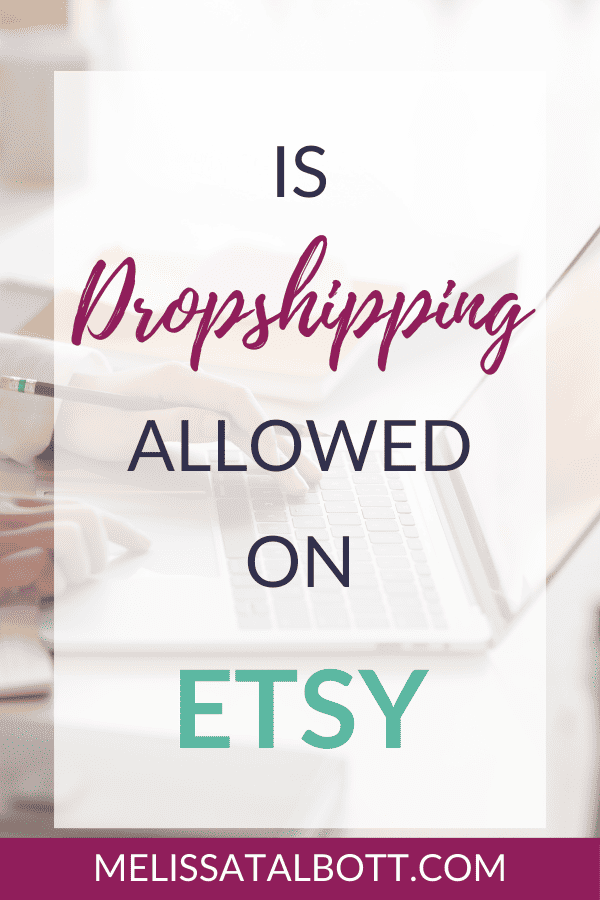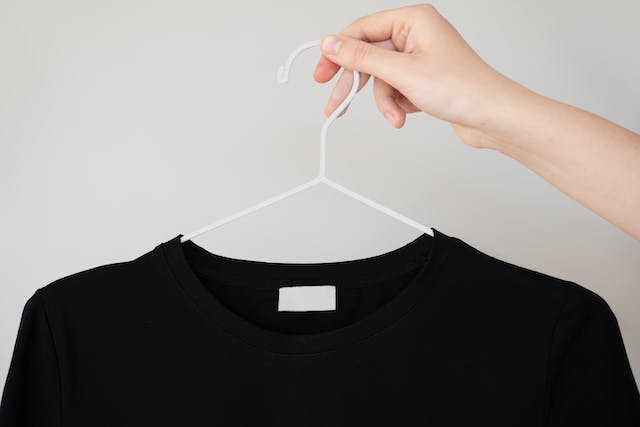Many Etsy sellers are looking for new ways to do business and create passive income. One of the ways Etsy shops are able to do this is through dropshipping.
This has been a controversial topic among Etsy sellers ever since Etsy started to allow sellers to use production partners as a way to produce their products.

Just a heads up! This blog post may contain affiliate links. That means if you make a purchase through one of those links, at no additional cost to you, I may make a commission from your purchase, which helps me provide this content to you!
Can I Do Dropshipping On Etsy?
As Etsy sellers look for ways to expand their businesses, passive income is one of those income streams that is usually appealing, and sellers will oftentimes look to dropshipping as that avenue.
According to Etsy’s current seller policies, Etsy does not explicitly prohibit dropshipping. Etsy does stipulate, however, that the products sold on its marketplace platform must abide by very specific guidelines. Failure to adhere to these guidelines could result in the suspension of your Etsy seller account and being banned from selling on Etsy permanently.
Etsy states that your items must be handmade, craft supplies or vintage.
If you’d like more about these policies, check out this article about what you can sell on Etsy.
I’ll go further into the details with examples of those categories in just a bit.
So, what is dropshipping?
Dropshipping is when your customer makes a purchase from your business. You then have that product created and shipped directly from the production company to the buyer.
This is a very hands-off business model. Which is one of the reasons it has become so popular and is very appealing at first glance.
Don’t forget to join my FREE Etsy Seller Success Facebook Group!
Businesses across the globe have adapted dropshipping models for a whole host of reasons from, quicker shipping to the buyer, being a distribution-style business where you source leads and make the sale but don’t actually produce your own inventory (think Amazon’s marketplace), cheaper production costs, etc.
In order to sell products that are dropshipped from another company to the customer who made a purchase from your Etsy shop, you will most likely have to play the middleman. It can be somewhat difficult to actually run a dropshipping business on the platform, though it can be done.
Etsy does, however, now allow its sellers to connect to various print on demand (POD) companies and other fulfillment companies, known as “Production Partners”. Companies like Printify and Printful are two of the largest print on demand companies that Etsy sellers work with daily.
Now, let’s take a look at how you could possibly integrate a dropshipping aspect to your Etsy shop.
Here are some examples of dropshipping in your Etsy shop.
What Kinds of Products Can I Dropship In My Etsy Shop?
Print On Demand Products
Loads of these products are being sold on Etsy these days. Think mugs, t-shirts, fabrics and prints.
As a print on demand shop, you must be designing the graphics, etc. that are being created by the fulfilling company. This is part of the stipulations for Etsy sellers working with production partners. You must be creating part of this finished product and that is usually the design work. Otherwise, you aren’t following the guidelines of “handmade” and could get the boot from the platform.
Etsy also requires you to tell your buyers that you are working with a production company. This is simply for full transparency as Etsy has been known as a “handmade” platform for years, and the introduction of production partners was confusing when first allowed on the platform.

One thing to keep in mind with a dropshipping business model is that the profits can be smaller on a per item basis as you are sharing that production cost with a fulfillment company, and they need to get paid too so you, in turn, are charged the cost of the item production as well as the shipping fees.
POD shops can be profitable but you will really have to watch your margins and make sure you are factoring in all the expenses, including fees from Etsy, fees from the POD fulfillment company and the shipping expense into the retail price of your items listed for sale. If you do not accurately account for all expenses, you will not make a profit.
There is usually a lot of competition for these types of products as more shops move to a “passive income” business model. So there will be stiff pricing competition. Many times, POD shops are only looking at making a few dollars profit per item once it’s all said and done. But not much work is being done after the initial designing and listing phase.

You will also need to find a way to stand out from the competition to be found so you may have higher marketing costs as well. With POD, there is simply a smaller barrier to entry as sellers wouldn’t have to buy any large, expensive equipment, and anyone with a bit of graphic design knowledge can start a POD shop in just a few minutes. I’ve even seen some YouTube Channels show designers how to make hundreds of products for print on demand using software like Canva in a matter of hours. Not days, weeks or months, but hours.
A thing to note about shipping with a POD is making sure that their production times are consistent with the production times that you have in the listing. During busy seasons, these times become more fluid and can change quickly and products can even become out-of-stock so you will need to stay on top of that to ensure your customers are receiving their order within the expected time frames or you could incur refunds and bad reviews.
I have used print on demand services within my own businesses for situations where I don’t have the tools needed to produce products like mugs, notebooks, apparel, wall art prints, etc. Don’t be afraid to give it a try and see if it’s right for you and your business too.
Are you thinking about starting your own Etsy shop?? Use this link to get 40 FREE listing credits!!
In all, if you are looking for a side income that doesn’t involve tons of start up costs or time, dropshipping on Etsy using a POD production partner could be a good fit for you.
Craft Supply Products
You can sell craft supply products in your Etsy shop as well. But again, you need to be part of the design process in order to do dropshipping of craft supplies.
NO dropshipping straight from Aliexpress. That’s a no go as these aren’t made by you, you aren’t creating anything, you aren’t shipping it, and it isn’t vintage.
You could, however, be a surface pattern designer selling printed fabric to crafters in your Etsy shop and the production partner could be a company like Spoonflower, known for their fabric print services for designers.
One hard part about doing this as a dropshipping business model is that you will need to manually fulfill these products as there aren’t any, that I know of, integrations like there are with other POD that can be directly connected to an Etsy shop for fulfillment when orders come through.

In this case, your buyer would make a purchase. You, the seller on Etsy, would then go to the dropshipping company of your choice (Spoonflower in this example) and make the purchase on the buyer’s behalf, add their shipping information and complete the purchase. The fulfillment company then ships the item to the buyer. And you keep the difference of buyer transaction price minus expenses as profit in your pocket.
Again, a fairly passive, hands-off business model too, but with a bit more computer work with each transaction.
I would, in the case of a fabric designer, sell directly on Spoonflower’s website or open my own e-commerce site with a host like Shopify where I wouldn’t incur as many fees to keep my expenses down.
You can sell other craft supplies that are not handmade, but then you would need to purchase them first and have them shipped to you to then be shipped out to buyers when an order comes in from your Etsy shop. That’s a lot of shipping costs.

Think about selling beads. How many THOUSANDS of beads would have to be sold when your margins may only be pennies per order? There isn’t much of a return on your time of packaging and shipping to your buyer.
You would have to generate lots of sales to make it very profitable once the cost of the item and the shipping is taken into account. Supplies are a very inexpensive product and just don’t have high margins to begin with. Many craft suppliers are from outside the U.S. and now have their own Etsy shops so you could possibly be competing with the supplier itself.
Another aspect of purchasing from big suppliers, oftentimes located in different countries, is that those supplies could take months to actually receive the supplies once shipped. The literal slow boat from China. This could mean longer than expected delivery times with you out the money with no product on hand to sell. So keep that in mind as well.

I’ve seen this first hand with suppliers as a family member with an Etsy shop would order from an overseas towel supplier. She would embroider the towels as part of her business. She would sometimes wait 6 months or more for her items to arrive. Sometimes her orders would just get canceled by the suppliers.
Then the time she spent embroidering custom orders.
No thanks.
Selling dropshipped craft supplies would not be on my top list of business models for an Etsy shop with the margins being so low and possible shipping issues alone. Nope, I’ll pass and find something else to do.
As a whole, I would not recommend dropshipping craft supplies as a business model but would recommend print on demand dropshipping for Etsy sellers looking for passive income revenue streams.




